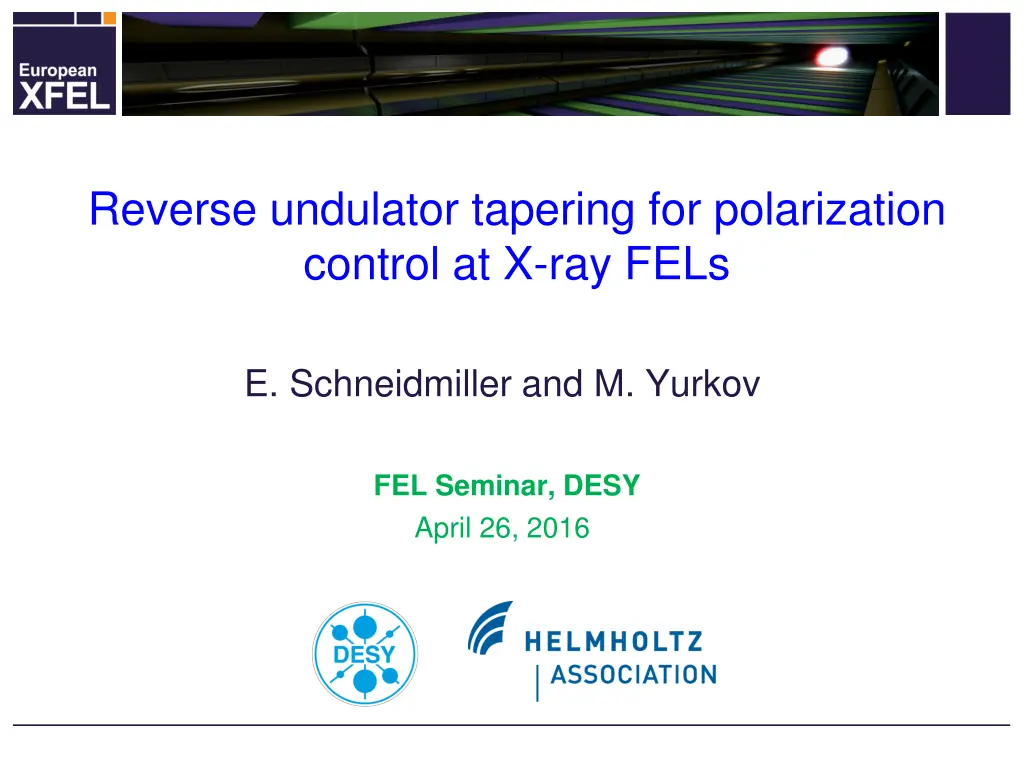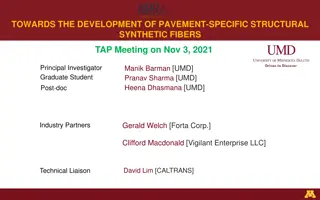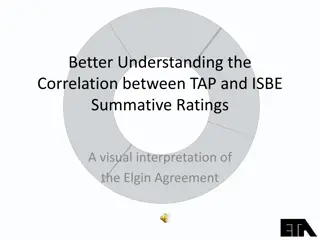
Innovative Undulator Tapering for X-ray FELs
Explore the use of reverse undulator tapering for polarization control in X-ray Free Electron Lasers (FELs). Learn about circular polarization techniques and recent advancements in mainstream and reverse tapering methods for enhancing FEL efficiency and beam power control. Discover how reverse tapering can produce strong microbunching with reduced radiation power, opening up new possibilities for X-ray FEL applications.
Download Presentation

Please find below an Image/Link to download the presentation.
The content on the website is provided AS IS for your information and personal use only. It may not be sold, licensed, or shared on other websites without obtaining consent from the author. If you encounter any issues during the download, it is possible that the publisher has removed the file from their server.
You are allowed to download the files provided on this website for personal or commercial use, subject to the condition that they are used lawfully. All files are the property of their respective owners.
The content on the website is provided AS IS for your information and personal use only. It may not be sold, licensed, or shared on other websites without obtaining consent from the author.
E N D
Presentation Transcript
Reverse undulator tapering for polarization control at X-ray FELs E. Schneidmiller and M. Yurkov FEL Seminar, DESY April 26, 2016
Circular polarization for X-ray FEL facilities 2 Strongly requested by the user community Especially interesting is soft X-ray regime Undulators are planar There are many ideas for circular polarization production (following K.-J. Kim s cross-planar configuration) E. Schneidmiller and M. Yurkov, Workshop on variable polarization at SASE3, European XFEL, Feb. 11, 2016
Mainstream for circular polarization production 3 Main SASE undulator is planar Install helical afterburner Try to get rid of powerful linearly polarized radiation from the main undulator helical afterburner planar undulator (saturation) E. Schneidmiller and M. Yurkov, Workshop on variable polarization at SASE3, European XFEL, Feb. 11, 2016
Recent idea: reverse taper 4 reverse-tapered planar undulator (saturation) helical afterburner Fully microbunched electron beam but strongly suppressed radiation power at the exit of reverse-tapered planar undulator The beam radiates at full power in the helical afterburner tuned to the resonance E. Schneidmiller and M. Yurkov, Phys. Rev. ST-AB 110702(2013)16
Standard (positive) taper 5 Undulator K decreases along the undulator length; Positive taper is used to - compensate beam energy loss due to spontaneous undulator radiation and wakefields; - increase power of a high-gain FEL after saturation (post-saturation taper)
Reverse (negative) taper 6 Undulator K increases along the undulator length; Two applications were proposed for FELs: - to increase efficiency of FEL oscillators Saldin, Schneidmiller, Yurkov, Opt. Commun. 103(1993)297 - to use in an attosecond scheme for X-ray FELs combining taper and energy chirp in a short slice Saldin, Schneidmiller, Yurkov, Phys. Rev. ST-AB 9(2006)050702 Now we discover another useful feature of the reverse taper: a possibility to produce strong microbunching at a very much reduced radiation power
1D parameters 7 Detuning parameter Normalized longitudinal coordinate Gain parameter ( inverse gain length at resonance) Now let K be linear function of z:
SASE FEL: 1D simulations 8 b bunching (0<b<1) normalized power (efficiency) energy spread parameter = 0.2 Relative increase of the saturation length Bunching and power at saturation
Frequency shift 9 In a SASE FEL the evolution of the amplified frequency band depends on tapering. Consider the asymptote of a large parameter | For positive parameter, the frequency follows the change of resonance completely. For negative parameter, it doesn t follow current resonance at all; it stays at the resonance with undulator parameters at its entrance.
Steady-state, exponential gain regime 10 Consider monochromatic seed, no taper but large negative detuning: , Scaled gain length is now ?? One can solve initial-value problem and find for the exponential gain regime: field bunching energy modulation
Steady-state, exponential gain regime: resonance 11 Scaled gain length is now ?? 1 field 1 1 bunching energy modulation 1
SASE FEL, large reverse paper 12 Now SASE and large reverse taper. The FEL frequency band stays close to resonance at the undulator entrance (and not at the present position), i.e. detuning increases as the beam propagates through the undulator. Gain length also increases and the ratio is Since gain length increases along the undulator length, an increase in saturation length is smaller than an increase in last gain length(s).
3D bonus 13 Transverse mode gets more narrow for negative detuning. Thus, the field acting on particles is stronger for the same power. B = 0.1 C = 0 C=-20
Results of simulations with FAST 15 400 power bunching E. Schneidmiller and M. Yurkov, Workshop on variable polarization at SASE3, European XFEL, Feb. 11, 2016
Reverse taper at LCLS 16 Courtesy H.-D. Nuhn
FLASH layout 17 Undulators Period 2.73 cm 3.14 cm Length 27 m (6 x 4.5 m modules) fixed gap 30 m (12 x 2.5 m modules) variable gap FLASH1: FLASH2: E. Schneidmiller and M. Yurkov, Workshop on variable polarization at SASE3, European XFEL, Feb. 11, 2016
Reverse taper experiment at FLASH2 18 23.01.2016 Beam energy 720 MeV, wavelength 17 nm. Reverse taper (10%) was applied to the 10 undulator segments; the gap of the 11thand 12th segments was scanned. reverse-tapered undulator afterburner Power ratio of 200 was obtained. For a helical afterburner it would be larger by a factor of 2. 200 (x 2) E. Schneidmiller and M. Yurkov, Workshop on variable polarization at SASE3, European XFEL, Feb. 11, 2016
Reverse taper experiment at FLASH2 (contd) 19 200 (x 2) Simulations for SASE3 400 E. Schneidmiller and M. Yurkov, Workshop on variable polarization at SASE3, European XFEL, Feb. 11, 2016
Experiment at FLASH2 on March 12 20 We repeated the reverse taper experiment at the same wavelength but at a higher electron energy (930 MeV) on March 12. Rms undulator parameter was 1.6, and the ten undulator sections were reverse-tapered by 5 %. The pulse energy was 0.25 microjoules, while after tuning the 11th and the 12th sections to the resonance it reached 60 microjoules, i.e. the contrast above 200 was demonstrated again. We could also tune the "afterburner" to the second harmonic and measure 1.8 microjoules. This is an important demonstration because a harmonic afterburner with variable polarization might be installed at FLASH2. Reverse tapering in the main undulator will provide background-free radiation from the afterburner. E. Schneidmiller and M. Yurkov, Workshop on variable polarization at SASE3, European XFEL, Feb. 11, 2016
Conclusion 21 A method for suppression of linearly polarized background and obtaining high degree of circular polarization is proposed The method is free and easy to implement It is routinely used at LCLS and shown to work nicely at FLASH2 The method will be used for SASE3 undulator of the European XFEL, it can also be used for FLASH2 with harmonic afterburner






















